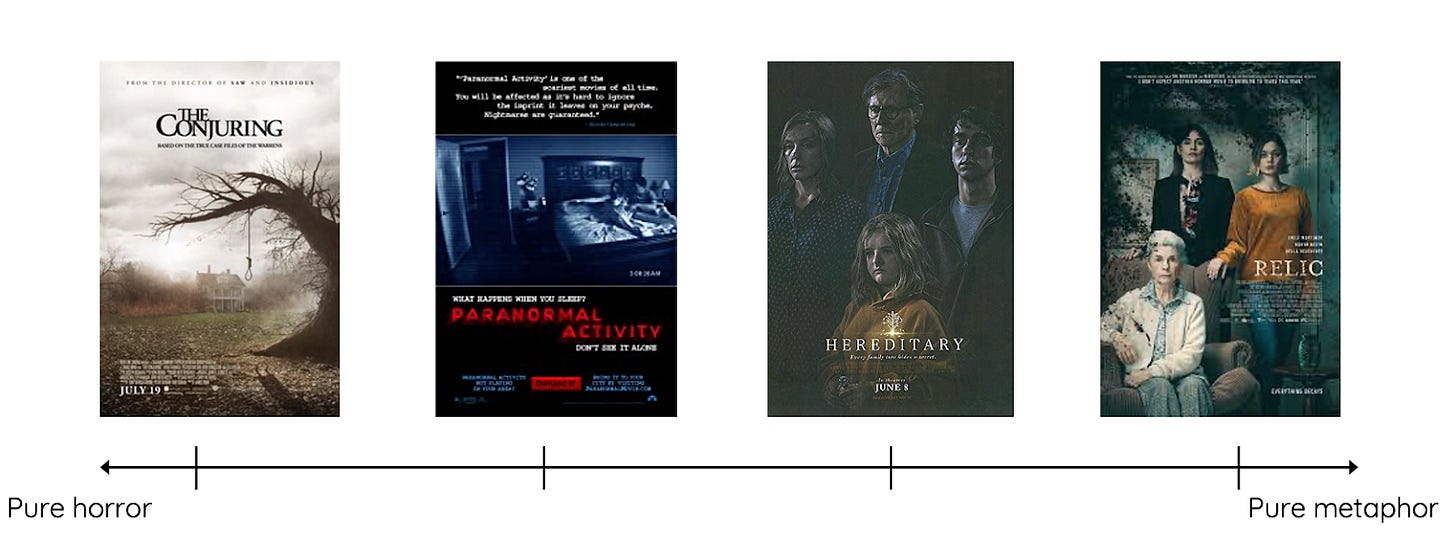I am a life-long scaredy cat. I have never voluntarily gone through a haunted house, I cried in a stand-off against a nearly-dead cockroach, and I still can’t ride Splash Mountain at Disneyland. This is a truth I’ve always known about myself: I don’t enjoy the feeling of being scared, which means I’ve never understood the appeal of horror movies.
Horror has long struck me as a scare fest, sort of like bungee-jumping for film adrenaline junkies. What’s the point of the genre, if not to terrorize you? Movies like Saw, which seem to offer a kind of pointless grisliness, have always reinforced this idea to me.
I was forced to revise my opinion when I finally watched Ari Aster’s Hereditary (lights fully on, thank you). Hereditary, while being the scariest thing I’ve ever seen put to screen, is probably only half horror movie. Its other half is better categorized as family drama. The way the horror and the drama intricately intertwine prove that plot and character don’t have to play second fiddle to scary thrills. In fact, it can go in the opposite direction; those thrills can and should work in service of compelling plot and character.
Good film always reflects some truth about ourselves, and I’m learning that horror can be a particularly powerful mirror. Without the constraints of realism or the delicacy of most other genres, horror can literalize our ills and give us new ways to talk about difficult concepts. What if, to represent the fear and loss a disease like dementia creates, we could watch a grandmother literally haunted by the disease? What if a new version of the body-snatcher trope can literalize the way America covets black culture even as it dehumanizes black bodies? The horror genre warps our own reality, and thereby offers an effective vehicle to interpret recognizable concepts anew.
Take the classic “haunted house” trope. In the right hands, this horror staple can be transformed:
Pure horror (The Conjuring): Your house is literally haunted. Probably by Satan or an associated evil demon.
Horror-ish (Paranormal Activity): Your house is literally haunted. Probably still by a demon, but this time the demon could be explained by concepts other than Satan.
Metaphor-ish (Hereditary): Is the house haunted? Or are you? (The answer is BOTH).
Pure metaphor (Relic): You are the haunted house.
In “pure horror”, the movie isn’t interested in anything beyond horror as an end unto itself. This is why the explanations for the horror are often far removed from recognizable life or, more importantly, the characters themselves. In The Conjuring, a family moves into a haunted house. The haunting isn’t because of the characters— they’re merely passengers to what they’re experiencing.
I don’t think there’s anything wrong with this approach! However, the “pure metaphor” side of the spectrum appeals far more to a scaredy-cat like me, because the horror works in service of the film beyond itself. In Relic, a film about a grandmother suffering from dementia, the house becomes a claustrophobic maze of never-ending, always-changing corridors that get dimmer with every passing second. There’s plenty of jump scares and traditional horror moments, but all of it visualizes a broader concept: a grandmother trapped in the ever-contorting, ever-darkening maze of her own mind.
I’ve realized that horror’s vocabulary is so much more expansive than I originally thought: a haunted house doesn’t have to be just a haunted house anymore. Maybe that sounds simple, but to someone who’s shunned horror for the vast majority of her life, it feels like an epiphany. I’ve always thought horror had nothing to offer me, because I don’t like feeling scared. My opinion has changed, but not because I’ve gotten any braver— the horror genre is simply offering so much beyond pure terror that I can’t help but be interested.
(And just for fun, here’s every horror movie I’ve ever seen - it’s not many - diagrammed on the above scale!)

Meshes of the Afternoon
It’s rare that I get to recommend something you could watch while reading this newsletter, but Meshes of the Afternoon is only 13 minutes long and available on YouTube! I’ll admit that it’s equally rare for me to recommend a silent movie from 1943, but I’m willing to make an exception, because this short film is cool.
Maya Deren’s Meshes of the Afternoon is a surreal-ish dream sequence thriller. I watched it with no expectations but realized soon after that so many of the movies I love - Inception, Vertigo, Eternal Sunshine of the Spotless Mind, etc. - owe something, in one way or another, to this influential film.
What a funny feeling— to think that a woman from almost a century ago was interested in the very same concepts we’re interested in today. She may have had different technology, but Deren harnessed everything in her power to create something that holds up even now. The fact that this movie is so old but feels so modern makes me feel like I’m watching something primal and elemental, and it leaves me wondering how humans, across decades and miles of difference, can still be so much the same.
Culture Crumbs
An update on the Persuasion adaptation: Henry Golding has joined the cast— not as Wentworth but as Mr. Elliot!
A reminder that George Miller, the man who created Mad Max: Fury Road, also created Happy Feet, a truth that never fails to disturb me every few months
The reveal that Julia Stiles and JGL were super into each other when filming 10 Things I Hate About You, which is literally meaningless because it was like 20 years ago and they were teenagers, but is also critical, because 10 Things is a cinematic masterpiece and every detail about its creation must be documented accordingly
Finally, Sebastian Stan.
Thanks for reading this week! If you like this content, please consider subscribing (it’s free!)






